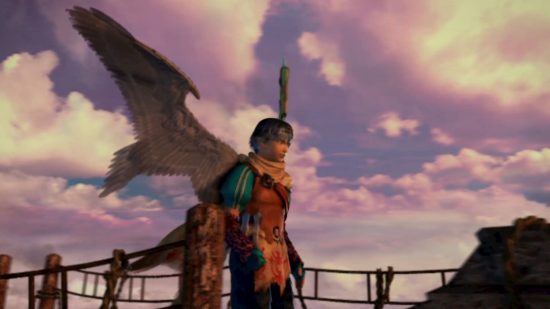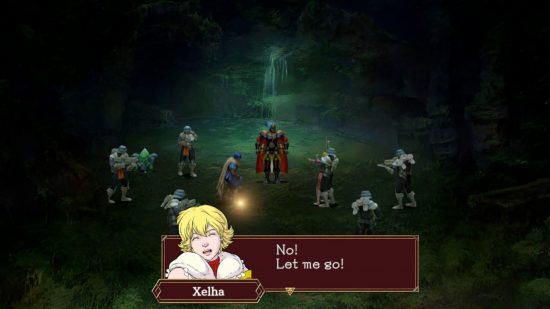Our Verdict
The Baten Kaitos I & II HD Remaster offers a wonderful glimpse into a well-received bit of Monolith Soft’s history, one that barely sold enough for us to expect a second look. While the remaster doesn’t do anything exceptional, it’s more than enough, and it’s such a delight to have a bit of history in the palm of your hand.
Monolith Soft is easily best known for the Xenoblade series. After coming under Nintendo’s umbrella in 2007, the company created a revered series that peaked with Xenoblade Chronicles 3 in 2022. Prior to that, Bandai Namco owned the company. But the Xeno-dev’s work with Nintendo stretches far beyond just four Xenoblade games.
See, Monolith Soft seems to touch everything that Nintendo makes nowadays. For the Nintendo Switch, the team has supported development on The Legend of Zelda: Breath of the Wild, Splatoon 2, Animal Crossing: New Horizons, Splatoon 3, and The Legend of Zelda: Tears of the Kingdom. All while putting out three Xenoblade games (albeit one remaster) and three DLCs for those games all on the same system.
To say Monolith is a star of the current era of Nintendo feels like an understatement. The team is a part of so much of the best of the Switch, allowed to keep making its quirky JRPGs as long as it supports Nintendo’s massive and marketable triple-A offerings. Well, all the quirks and unique joys of the Xenoblade series are apparent in the new Baten Kaitos I & II HD Remaster on Nintendo Switch. And getting a window into such an essential studio’s history is an absolute treat.
This package includes Baten Kaitos: Eternal Wings and the Lost Ocean, a Gamecube exclusive first launched in Japan in 2003. In spite of very lacklustre sales, the game got a sequel with Baten Kaitos Origins in 2006, also exclusive to the Gamecube. This also underperformed in terms of sales.

So, with two well-received but barely bought JRPGs now remastered and on a console that has sold over six times the number of the original games’ home, it’s a bit of a baffling scene. But it offers a joyous bit of weird game magic in the palms of people who’ve likely loved the developer’s more modern offerings.
Baten Kaitos: Eternal Wings and the Lost Ocean features Kalas, a somewhat rough and rude brooder on the hunt for revenge. He wakes up in a small village, meets a girl called Xelha. Quite quickly, they go off into the forest and accidentally summon a world-ending force. Everyone is quite annoyed about it, and now it’s their job to fix it.
So, classic JRPG fare when it comes to the story. However, the real fun starts when you dive into the mechanics. The battle system involves various cards, or Magnus, which are stacked in a deck for you to whip out in turn-based battle. Not traditional turn-based, mind you – once you start to attack, you have a limited amount of time to launch a follow up; and when the enemy attacks, you have a limited amount of time to deploy a defensive card.
These Magnus cards aren’t just used in battle, however. They’re sort of a catch all for any action. You can have blank cards to collect items to complete a fetch quest. You can have food Magnus to revive or heal characters outside of battle. You even have a camera card to take photos of enemies to sell for money when back in a town.
This camera sort of sums up the wonderful experiment that Baten Kaitos can often feel like. Once you take a photo of a monster, there’s nothing to do with it other than sell it. But you can’t sell it straight away as it needs to develop. This feels immediately odd; to have an in-world explanation for something that doesn’t make immediate mechanical sense. But once you get into it, you realize the oddness is the charm.
This is where hints of Xenoblade crop up, too. Early on, at the beginning of the first game, Xelha’s relatives die, and she performs some sort of ceremony before their bodies dissolve. This immediately made me think of Xenoblade Chronicles 3. This feeling crops up constantly throughout a playthrough, assuming you’re new to Baten Kaitos like I am.
The enemy designs are particularly wonderful, with strangely human-faced creatures and big-nosed villains in vaudeville makeup. The world is similarly colorful and creative, with a fantasy that feels more fairytale than sci-fi. Again, this is the sort of line Monolith has often crossed over – XC2 is fairytale, XC3 is sci-fi. Oh, and everyone lives on floating islands too… sound familiar?
The real magic of Baten Kaitos comes when you get deeper into the battle system. It works like poker, with straights and pairs required to perform a combo. Each card has a number on it. You can either pair these up, or get them in order for a more powerful attack. It’s such a simple foundation – a matching task, basically – but the fact that it’s shown so plainly is refreshing. It’s just numbers, not disguised by some in-game vernacular.
Getting through the first game, however, is a matter of patience. It’s not exactly hard, but it’s definitely not easy. Luckily, these two remasters offer a small amount of quality of life additions to make its old design a little smoother for the modern player. You can turn off encounters, instantly KO enemies, triple the game speed, simplify battle results, and turn on a slightly brainless autobattle. The games can be simplified, which is great.
One of the unique aspects shared by both games is, well, you – the player. You’re a guardian spirit for the protagonist in each game. What this means is that the character talks to you, and everything can get a little meta. It’s not something like Psycho Mantis saying you like Castlevania – it’s a bonding system between you and the main character that you control.
Depending on what you say, your bond with Kalas or Sagi (the protagonist in the second game) can change. These characters can like or dislike you. They can ask for advice, and you can be rude or nice. The stronger your bond with the main character, the more bonuses you can get in a battle.
Now, it mostly makes me think of some morality system, the kind you’d find in Red Dead Redemption. But the fact that it sits in an already deep and hefty JRPG that’s two decades old and overflowing with ideas makes this game feel important. It makes it a game that’s a must-play for the fact that it’s interesting, moreso than it’s entertaining.
Food can go rotten, elements can combine with weapons for new powers, and the main character can talk to you. You need to develop photos in real time, combine cards like a game of poker, and collect what feels like an endless list of Magnus. It’s such a massive amount of ideas. And I love it for that alone.
All this is compounded if you already have an interest in Monolith Soft, too. To peer through a window into the past of such an important Switch developer deepens your understanding of the present. It makes you more deeply appreciate and understand something you might already love. Then again, if you’re not into Xenoblade or just have a passing interest in JRPGs, it might not be for you. But if it is for you, it’s very much most definitely and loudly for you.
For more, check out our guide to the best JRPGs. We’ve also got a Xenoblade Chronicles 3 review if you want to learn more about Monolith’s most recent offering.




